Cayman Islands
The Cayman Islands (/ˈkeɪmən/ or /keɪˈmæn/) is an autonomous British Overseas Territory in the western Caribbean Sea. The 264-square-kilometre (102-square-mile) territory comprises the three islands of Grand Cayman, Cayman Brac and Little Cayman, which are located to the south of Cuba and northeast of Honduras, between Jamaica and Mexico's Yucatán Peninsula. The capital city is George Town on Grand Cayman, which is the most populous of the three islands.
Cayman Islands | |
|---|---|
| Motto(s): "He hath founded it upon the sea" | |
| Anthem: "God Save the Queen" | |
| National song: "Beloved Isle Cayman" | |
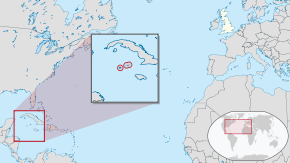 Location of Cayman Islands (circled in red) | |
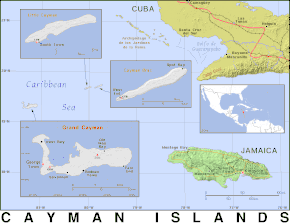 | |
| Sovereign state | United Kingdom |
| English control | 1670 |
| Self-government | 4 July 1959 |
| Separation from Jamaica | 6 August 1962 |
| Current constitution | 6 November 2009 |
| Capital and largest city | George Town 19°20′N 81°24′W |
| Official languages | English |
| Vernacular languages | Cayman Islands English |
| Ethnic groups (2011) | 40% Multiracial 20% Black 20% White 20% Asian[1] |
| Demonym(s) | Caymanian |
| Government | Parliamentary dependency under a constitutional monarchy |
• Monarch | Elizabeth II |
• Governor | Martyn Roper |
• Premier | Alden McLaughlin |
| Legislature | Legislative Assembly |
| Government of the United Kingdom | |
• Minister | Elizabeth Sugg |
| Area | |
• Total | 264 km2 (102 sq mi) |
• Water (%) | 1.6 |
| Highest elevation | 141 ft (43 m) |
| Population | |
• 2019 estimate | 65,813 [2] (206th) |
• Density | 244/km2 (632.0/sq mi) (59th) |
| GDP (PPP) | 2014[3] estimate |
• Total | $2.507 billion[3] |
• Per capita | $73,800 (2004 est.)[3] |
| GDP (nominal) | 2018 estimate |
• Total | $4.571 billion [4][5] (160th) |
• Per capita | $70,956 (2018 est.)[4][5] (7th) |
| HDI (2013) | 0.888 very high |
| Currency | Cayman Islands dollar (KYD) |
| Time zone | UTC-5:00 (EST) |
| Date format | dd/mm/yyyy |
| Driving side | left |
| Calling code | +1-345 |
| UK postcode | KYx-xxxx |
| ISO 3166 code | KY |
| Internet TLD | .ky |
The Cayman Islands is considered to be part of the geographic Western Caribbean Zone as well as the Greater Antilles. The territory is often considered a major world offshore financial haven for international businesses and many wealthy individuals.[6] It has been placed on the EU's blacklist of foreign tax havens.[7]
History
No archaeological evidence for an indigenous presence has been found on the Cayman Islands.[8] Therefore, it is believed that they were discovered by Christopher Columbus on 10 May 1503 during his final voyage to the Americas.[9][10] He named them 'Las Tortugas' due to the large number of turtles found on the islands (which were soon hunted to near-extinction);[9][11] however, in the succeeding decades the islands began to be referred to as the Caymans, after the caimans present there.[10][9] No immediate colonisation occurred following Columbus's discovery; however, a variety of settlers from various backgrounds made their home on the islands, including pirates, shipwrecked sailors, and deserters from Oliver Cromwell's army in Jamaica.[12] Sir Francis Drake briefly visited the islands in 1586.[13]
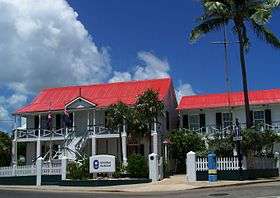
The first recorded permanent inhabitant of the Cayman Islands, Isaac Bodden, was born on Grand Cayman around 1661. He was the grandson of the original settler named Bodden who was probably one of Oliver Cromwell's soldiers at the taking of Jamaica in 1655.[14]
England took formal control of the Cayman Islands, along with Jamaica, as a result of the Treaty of Madrid of 1670.[10] That same year saw an attack on a turtle fishing settlement on Little Cayman by the Spanish under Manuel Ribeiro Pardal.[13] Following several unsuccessful attempts at settlement in what had by now become a haven for pirates,[11] a permanent English-speaking population in the islands dates from the 1730s.[11] With settlement, after the first royal land grant by the Governor of Jamaica in 1734, came the perceived need for slaves.[15] Many were brought to the islands from Africa; this is evident today with the majority of native Caymanians being of African and/or English descent.[10] The results of the first census taken in the islands in 1802 showed the population on Grand Cayman to be 933, with 545 of those inhabitants being enslaved.[11] Slavery was abolished in the Cayman Islands in 1833. At the time of abolition, there were over 950 blacks of African ancestry enslaved by 116 white families of English ancestry.[16][9]
On June 22 1863, the Cayman Islands became officially declared and administered as a dependency of the Crown Colony of Jamaica.[17] The islands continued to be governed as part of the Colony of Jamaica until 1962, when they became a separate Crown colony while Jamaica became an independent Commonwealth realm.[18][10]
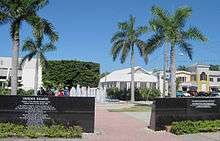
On February 8 1794, the Caymanians rescued the crews of a group of ten merchant ships, including HMS Convert, an incident that has since become known as the Wreck of the Ten Sail.[9][11] The ships had struck a reef and run aground during rough seas.[19] Legend has it that King George III rewarded the island with a promise never to introduce taxes as compensation for their generosity, as one of the ships carried a member of the King's own family. While this remains a popular legend, the story is not true.[20][11]
In the 1950s, tourism began to take off with the opening of the airport, a bank and several hotels, plus a number of scheduled flights and cruise stop-overs.[13][11] Politically the Cayman Islands were an internally self-governing territory of Jamaica from 1958 to 1962; however, they reverted to direct British rule following the independence of Jamaica in 1962.[10] In 1972, a large degree of internal autonomy was granted by a new constitution, with further revisions being made in 1994.[10] The Cayman Islands government focused on boosting the territory's economy via tourism and off-shore finance, both of which mushroomed from the 1970s onwards.[11][10] The Caymans have historically been a tax-exempt destination, and the government has always relied on indirect and not direct taxes. The territory has never levied income tax, capital gains tax, or any wealth tax, making them a popular tax haven.[21]
The constitution was further modified in 2001 and 2009, codifying various aspects of human rights legislation.[10]
On 11 September 2004 the island of Grand Cayman, which lies largely unprotected at sea level, was hit by Hurricane Ivan, creating an 8-ft (2.4 m) storm surge which flooded many areas of Grand Cayman.[10] An estimated 83% of the dwellings on the island were damaged including 4% requiring complete reconstruction. A reported 70% of all dwellings suffered severe damage from flooding or wind. Another 26% sustained minor damage from partial roof removal, low levels of flooding, or impact with floating or wind driven hurricane debris.[22] Power, water and communications were disrupted for months in some areas as Ivan was the worst hurricane to hit the islands in 86 years.[23] Grand Cayman began a major rebuilding process and within two years its infrastructure was nearly returned to pre-hurricane status. Due to the tropical location of the islands, more hurricanes or tropical systems have affected the Cayman Islands than any other region in the Atlantic basin; it has been brushed or directly hit, on average, every 2.23 years.[24]
Geography
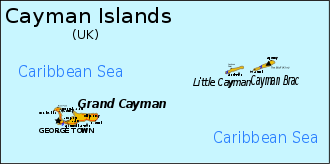
The islands are in the western Caribbean Sea and are the peaks of an undersea mountain range called the Cayman Ridge (or Cayman Rise). This ridge flanks the Cayman Trough, 6,000 m (20,000 ft) deep[25] which lies 6 km (3.7 mi) to the south.[26] The islands lie in the northwest of the Caribbean Sea, east of Quintana Roo, Mexico and Yucatán State, Mexico, northeast of Costa Rica, north of Panama, south of Cuba and west of Jamaica. They are situated about 700 km (430 mi) south of Miami,[27] 750 km (470 mi) east of Mexico,[28] 366 km (227 mi) south of Cuba,[29] and about 500 km (310 mi) northwest of Jamaica.[30] Grand Cayman is by far the largest, with an area of 197 km2 (76 sq mi).[31] Grand Cayman's two "sister islands", Cayman Brac and Little Cayman, are about 120 km (75 mi) east north-east of Grand Cayman and have areas of 38 and 28.5 km2 (14.7 and 11.0 sq mi)[32] respectively. The nearest land mass from Grand Cayman is the Canarreos Archipelago (about 150 miles away), whereas the nearest from the easternmost island Cayman Brac is the Jardines de la Reina archipelago (about 100 miles away) - both of which are part of Cuba.
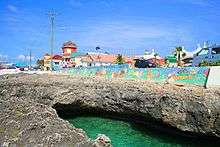
All three islands were formed by large coral heads covering submerged ice age peaks of western extensions of the Cuban Sierra Maestra range and are mostly flat. One notable exception to this is The Bluff on Cayman Brac's eastern part, which rises to 43 m (141 ft) above sea level, the highest point on the islands.[33]
Terrain is mostly a low-lying limestone base surrounded by coral reefs.
Fauna
The mammalian species in the Cayman Islands include the introduced Central American agouti[34] and eight species of bats. At least three now extinct native rodent species were present until the discovery of the islands by Europeans. Marine life around the island of the Grand Cayman includes tarpon, silversides (Atheriniformes), French angelfish (Pomacanthus paru), and giant barrel sponges. A number of cetaceans are found in offshore waters. These species include the goose-beaked whale (Ziphius cavirostris), Blainville's beaked whale (Mesoplodon densirostris) and sperm whale (Physeter macrocephalus).
Cayman avian fauna includes two endemic subspecies of Amazona parrots: Amazona leucocephala hesterna or Cuban amazon, presently restricted to the island of Cayman Brac, but formerly also on Little Cayman, and Amazona leucocephala caymanensis or Grand Cayman parrot, which is native to the Cayman Islands, forested areas of Cuba, and the Isla de la Juventud. Little Cayman and Cayman Brac are also home to red-footed and brown boobies.[35][36] Although the barn owl (Tyto alba) occurs in all three of the islands they are not commonplace. The Cayman Islands also possess five endemic subspecies of butterflies.[37] These butterfly breeds can be viewed at the Queen Elizabeth II Botanic Park on the Grand Cayman.
Among other notable fauna at the Queen Elizabeth II Botanic Park is the critically threatened blue iguana which is also known as the Grand Cayman iguana (Cyclura lewisi). The blue iguana is endemic to the Grand Cayman[38] particularly because of rocky, sunlit, open areas near the island's shores that are advantageous for the laying of eggs. Nevertheless, habitat destruction and invasive mammalian predators remain primary reasons that blue iguana hatchlings do not survive naturally.[39]
The Cuban crocodile (Crocodylus rhombifer) once inhabited the islands.[40] The name "Cayman" is derived from a Carib word for various crocodilians.[41]
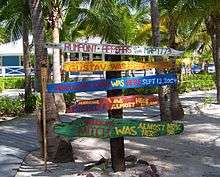
Climate
The Cayman Islands has a tropical wet and dry climate, with a wet season from May to October, and a dry season that runs from November to April. Seasonally, there is little temperature change.[42]
A major natural hazard is the tropical cyclones that form during the Atlantic hurricane season from June to November.
On 11 and 12 September 2004, Hurricane Ivan struck the Cayman Islands. The storm resulted in two deaths and caused great damage to the infrastructure on the islands. The total economic impact of the storms was estimated to be $3.4 billion.[43]
Demographics
According to the Economics and Statistics Office of the Government of the Cayman Islands, the Cayman Islands had a population of about 68,076 as of spring 2019.[44] The Cayman Islands has more registered businesses than people.[45] In 2018, the Cayman Islands had an estimated population of about 64,174 according to the United Nations,[46][47] representing a mix of more than 100 nationalities. The majority of the population resides on Grand Cayman, followed by Cayman Brac and Little Cayman.[3]
District populations
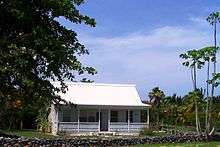
According to the Cayman Islands 2018 Compendium of Statistics released by the Economics and Statistics Office (ESO) the estimated resident population is 65,813 people,[48] broken down as follows:
- George Town: 34,878
- West Bay: 12,624
- Bodden Town: 12,649
- North Side: 1,678
- East End: 1,979
- Cayman Brac and Little Cayman (Sister Islands): 2,006
Religion
The predominant religion on the Cayman Islands is Christianity [49](81.9%). Collectively, Protestants account for 67.8%,[49] while the Roman Catholic Church accounts for 14.1%.[49] Denominations practiced include United Church, Church of God, Anglican Church, Baptist Church, Roman Catholic Church, Seventh-day Adventist Church, and Pentecostal Church. Roman Catholic churches are St. Ignatius Church, George Town and Stella Maris Church, Cayman Brac. Many citizens are deeply religious, regularly going to church. Ports are closed on Sundays and Christian holidays. There are places of worship in George Town for Jehovah's Witnesses and followers of the Bahá'í faith. The Cayman Islands also hosts a growing Jewish community.[49]
.jpg)
Languages
The official language of the Cayman Islands is English (90%)[49]. Islanders' accents retain elements passed down from English, Scottish, and Welsh settlers (among others) in a language variety known as Cayman Creole. Caymanians of Jamaican origin speak in their own vernacular (see Jamaican Creole and Jamaican English). It is also quite commonplace to hear some residents converse in Spanish[49] as many citizens have relocated from Latin America to work and live on Grand Cayman. The Latin American nations with greatest representation are Honduras, Cuba, Colombia, Nicaragua, and the Dominican Republic. Spanish speakers comprise approximately between 10-12% of the population and is predominantly of the Caribbean dialect. Tagalog is spoken by about 5% of inhabitants most of whom are Filipino residents on work permits.[49]
Economy
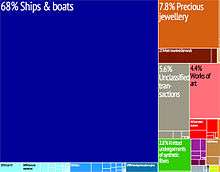
The main work on the island is financial services: there are 100,000 registered companies there, more than the population itself. Referring to one building on Cayman, Ugland House, former US president Barack Obama said it housed "12,000 corporations. Now, that's either the biggest building or the biggest tax scam on record."[50]
With an average income of around KYD$47,000, Caymanians have the highest standard of living in the Caribbean. According to the CIA World Factbook, the Cayman Islands GDP per capita is the 38th highest in the world, but the CIA's data for Cayman dates to 2004 and is likely to be lower than present-day values.[51] The territory prints its own currency, the Cayman Islands dollar (KYD), which is pegged to the US dollar US$1.227 to 1 KYD. However, in many retail stores throughout the islands, the KYD is typically traded at US$1.25.[52] The government has established a Needs Assessment Unit to relieve poverty in the islands.[53] Despite this, the Cayman Islands holds a relatively low unemployment rate of about 4.24% as of 2015,[54] lower than the value of 4.7% that was recorded in 2014.
The government's primary source of income is indirect taxation: there is no income tax, capital gains tax, or corporation tax.[21] An import duty of 5% to 22% (automobiles 29.5% to 100%) is levied against goods imported into the islands. Few goods are exempt; notable exemptions include books, cameras, gold, and perfume.[55]
Tourism
One of Grand Cayman's main attractions is Seven Mile Beach, site of a number of the island's hotels and resorts. Named one of the Ultimate Beaches by Caribbean Travel and Life, Seven Mile Beach is a public beach on the western shore of Grand Cayman Island.[56] Historical sites in Grand Cayman, such as Pedro St. James Castle in Savannah, also attract visitors.[57]
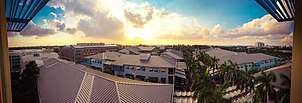
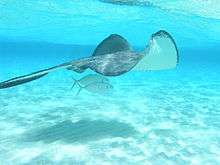
All three islands offer scuba diving, and the Cayman Islands is home to several snorkelling locations where tourists can swim with stingrays. The most popular area to do this is Stingray City, Grand Cayman. Stingray City is a top attraction in Grand Cayman and originally started in the 1980s, when divers started feeding squid to stingrays. The stingrays started to associate the sound of the boat motors with food, and thus visit this area year round.[58]
There are two shipwrecks off the shores of Cayman Brac, including the MV Captain Keith Tibbetts;[59] Grand Cayman also has several shipwrecks off its shores, including one deliberate one. On 30 September 1994 the USS Kittiwake was decommissioned and struck from the Naval Vessel Register. In November 2008 her ownership was transferred for an undisclosed amount to the government of the Cayman Islands, which had decided to sink the Kittiwake in June 2009 to form a new artificial reef off Seven Mile Beach, Grand Cayman. Following several delays, the ship was finally scuttled according to plan on 5 January 2011. The Kittiwake has become a dynamic environment for marine life. While visitors are not allowed to take anything, there are endless sights. Each of the five decks of the ship offers squirrelfish, rare sponges, Goliath groupers, urchins, and more. Experienced and beginner divers are invited to swim around the Kittiwake.[60] Pirates Week is an annual 11-day November festival started in 1977 by then-Minister of Tourism Jim Bodden to boost tourism during the country's tourism slow season.[61]
Other Grand Cayman tourist attractions include: the ironshore landscape of Hell; the 23-acre (93,000 m2) marine theme park "Cayman Turtle Centre: Island Wildlife Encounter", previously known as "Boatswain's Beach"; the production of gourmet sea salt; and the Mastic Trail, a hiking trail through the forests in the centre of the island. The National Trust for the Cayman Islands provides guided tours weekly on the Mastic Trail and other locations.[62]
Another attraction to visit on Grand Cayman is the Observation Tower, located in Camana Bay. The Observation Tower is 75 feet tall and provides 360-degree views across Seven Mile Beach, George Town, the North Sound, and beyond. It is free to the public and climbing the tower has become a popular thing to do in the Cayman Islands.[63]
Points of interest include the East End Light (sometimes called Gorling Bluff Light), a lighthouse at the east end of Grand Cayman island. The lighthouse is the centrepiece of East End Lighthouse Park, managed by the National Trust for the Cayman Islands; the first navigational aid on the site was the first lighthouse in the Cayman Islands.
Shipping
As of 31 December 2015 360 commercial vessels and 1,674 pleasure craft were registered in the Cayman Islands totaling 4.3 million GT.[64]
Labour
The Cayman Islands has a population of 68,076 (as of 2019) and therefore a limited workforce.[44] Work permits may, therefore, be granted to foreigners. On average, there have been more than 21,000 foreigners holding valid work permits.[65]
Work permits for non-citizens
To work in the Cayman Islands as a non-citizen, a work permit is required. This involves passing a police background check and a health check. A prospective immigrant worker will not be granted a permit unless certain medical conditions are met, including testing negative for syphilis and HIV. A permit may be granted to individuals on special work.
A foreigner must first have a job to move to the Cayman Islands. The employer applies and pays for the work permit.[66] Work permits are not granted to foreigners who are in the Cayman Islands (unless it is a renewal). The Cayman Islands Immigration Department requires foreigners to remain out of the country until their work permit has been approved.[67]
The Cayman Islands presently imposes a controversial "rollover" in relation to expatriate workers who require a work permit. Non-Caymanians are only permitted to reside and work within the territory for a maximum of nine years unless they satisfy the criteria of key employees. Non-Caymanians who are "rolled over" may return to work additional nine-year periods, subject to a one-year gap between their periods of work. The policy has been the subject of some controversy within the press. Law firms have been particularly upset by the recruitment difficulties that it has caused.[68] Other less well-remunerated employment sectors have been affected as well. Concerns about safety have been expressed by diving instructors, and realtors have also expressed concerns. Others support the rollover as necessary to protect Caymanian identity in the face of immigration of large numbers of expatriate workers.[69]
Concerns have been expressed that in the long term, the policy may damage the preeminence of the Cayman Islands as an offshore financial centre by making it difficult to recruit and retain experienced staff from onshore financial centres. Government employees are no longer exempt from this "rollover" policy, according to this report in a local newspaper.[70] The governor has used his constitutional powers, which give him absolute control over the disposition of civil service employees, to determine which expatriate civil servants are dismissed after seven years service and which are not.
This policy is incorporated in the Immigration Law (2003 revision), written by the United Democratic Party government, and subsequently enforced by the People's Progressive Movement Party government. Both governments agree to the term limits on foreign workers, and the majority of Caymanians also agree it is necessary to protect local culture and heritage from being eroded by a large number of foreigners gaining residency and citizenship.[71]
CARICOM Single Market Economy
In recognition of the CARICOM (Free Movement) Skilled Persons Act which came into effect in July 1997 in some of the CARICOM countries such as Jamaica and which has been adopted in other CARICOM countries, such as Trinidad and Tobago[72] it is possible that CARICOM nationals who hold the "A Certificate of Recognition of Caribbean Community Skilled Person" may be allowed to work in the Cayman Islands[73] under normal working conditions.
Government
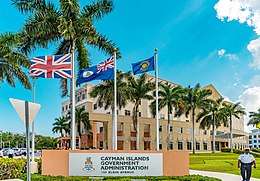
The Cayman Islands is a British overseas territory, listed by the UN Special Committee of 24 as one of the 16 non-self-governing territories. The current Constitution, incorporating a Bill of Rights, was ordained by a statutory instrument of the United Kingdom in 2009.[74] A 19-seat (not including two non-voting members appointed by the Governor which brings the total to 21 members) Legislative Assembly is elected by the people every four years to handle domestic affairs.[75] Of the elected Members of the Legislative Assembly (MLAs), seven are chosen to serve as government Ministers in a Cabinet headed by the Governor. The Premier is appointed by the Governor.[76]
A Governor is appointed by the Queen of the United Kingdom on the advice of the British Government to represent the monarch.[77] Governors can exercise complete legislative and executive authority if they wish through blanket powers reserved to them in the constitution.[78] Bills which have passed the Legislative Assembly require royal assent before becoming effective. The Constitution empowers the Governor to withhold royal assent in cases where the legislation appears to him or her to be repugnant to or inconsistent with the Constitution or affects the rights and privileges of the Legislative Assembly or the Royal Prerogative, or matters reserved to the Governor by article 55.[79] The executive authority of the Cayman Islands is vested in the Queen and is exercised by the Government, consisting of the Governor and the Cabinet.[80] There is an office of the Deputy Governor, who must be a Caymanian and have served in a senior public office. The Deputy Governor is the acting Governor when the office of Governor is vacant, or the Governor is not able to discharge his or her duties or is absent from the Cayman Islands.[81] The current Governor of the Cayman Islands is Martyn Roper.[82]
The Cabinet is composed of two official members and seven elected members, called Ministers; one of whom is designated Premier. The Premier can serve for two consecutive terms after which he or she is barred from attaining the office again. Although an MLA can only be Premier twice any person who meets the qualifications and requirements for a seat in the Legislative Assembly can be elected to the Legislative Assembly indefinitely.[83]
There are two official members of the Legislative Assembly, the Deputy Governor and the Attorney General. They are appointed by the Governor in accordance with Her Majesty's instructions, and although they have seats in the Legislative Assembly, under the 2009 Constitution, they do not vote. They serve in a professional and advisory role to the MLAs, the Deputy Governor represents the Governor who is a representative of the Queen and the British Government. While the Attorney General serves to advise on legal matters and has special responsibilities in the LA, he is generally responsible for changes to the Penal code among other things.
The seven Ministers are voted into office by the 19 elected members of the Legislative Assembly of the Cayman Islands. One of the Ministers, the leader of the majority political party, is appointed Premier by the Governor.
After consulting the Premier, the Governor allocates a portfolio of responsibilities to each Cabinet Minister. Under the principle of collective responsibility, all Ministers are obliged to support in the Assembly any measures approved by Cabinet.
Almost 80 departments, sections and units carry out the business of government, joined by a number of statutory boards and authorities set up for specific purposes, such as the Port Authority, the Civil Aviation Authority, the Immigration Board, the Water Authority, the University College Board of Governors, the National Pensions Board and the Health Insurance Commission.
Since 2000, there have been two official major political parties: The Cayman Democratic Party (CDP) and the People's Progressive Movement (PPM). While there has been a shift to political parties, many contending for office still run as independents. The two parties are notably similar, though they consider each other rivals in most cases, their differences are generally in personality and implementation rather than actual policy. The Cayman Islands currently lacks any real liberal or progressive representation in the Legislative Assembly or in the form of organized political parties.[84] As of the May 2017 General Election, members of the PPM and CDP have joined together with 3 independent members to form a government coalition despite many years of enmity.[85]
Law enforcement
The law enforcement in the country is provided chiefly by the RCIPS or Royal Cayman Islands Police Service and the CICBC or Cayman Islands Customs & Border Control. These two agencies co-operate in aspects of law enforcement, including their joint marine unit.[86] [87]
Military and defence
The defence of the Cayman Islands is the responsibility of the United Kingdom.
Cayman Regiment
On 12 October 2019, the government announced the formation of the Cayman Regiment, a new British Armed Forces unit. The Cayman Regiment was planned to become operational in 2020, with an initial 35-50 personnel of mostly reservists that are locally recruited and likely initially trained as engineers and expected growth of an increase of personnel to several hundred. [88][89] [90]
In mid-December 2019, recruitment for commanding officers and junior officers began, with the commanding officers expected to begin work in Jan 2020 and the junior officers expected to begin in February 2020.[91]
In January 2020, the first officers were chosen for the Cayman Regiment.[92]
Cadet Corps
The Cayman Islands Cadet Corps was formed in March 2001 and carries out military-type training with teenage citizens of the country.[93]
Coast Guard
As of 2017 the PPM led Coalition government have pledged to form a Coast Guard to protect the interests of the Islands, especially in terms of illegal immigration and illegal drug importation as well as Search and Rescue.
in Mid 2018 the Commander and 2nd in Command of the Cayman Islands Coast Guard were appointed. The First Commanding officer Appointed is Commander Robert Scotland and Second In Command Lieutenant Commander Leo Anglin [94]
In Mid 2019 the Commander and 2nd in Command took part in international joint operations with the United States Coast Guard and the Jamaica Defense Force Coast Guard called Operation Riptide. This making it first deployment for the Cayman Islands Coast Guard and first in 10 years any Cayman Representative has been on a foreign military ship for a counternarcotic operation.[95] [96]
In late November 2019 it was announced that the Cayman Islands Coast Guard would become operational in January 2020, with initial total of 21 Coast Guardsman half of which would come from the joint marine unit, with further recruitment in the new year. One of the many taskings of the Coast Guard will be to push enforcement of all laws that apply to the designated Wildlife Interaction Zone [97]
Taxation
No direct taxation is imposed on residents and Cayman Islands companies. The government receives the majority of its income from indirect taxation. Duty is levied against most imported goods, which is typically in the range of 22% to 25%. Some items are exempted, such as baby formula, books, cameras and certain items are taxed at 5%. Duty on automobiles depends on their value. The duty can amount to 29.5% up to $20,000.00 KYD CIF (cost, insurance and freight) and up to 42% over $30,000.00 KYD CIF for expensive models. The government charges flat licensing fees on financial institutions that operate in the islands and there are work permit fees on foreign labour. A 13% government tax is placed on all tourist accommodations in addition to US$37.50 airport departure tax which is built into the cost of an airline ticket. There are no taxes on corporate profits, capital gains, or personal income. There are no estate or death inheritance taxes payable on Cayman Islands real estate or other assets held in the Cayman Islands.
The legend behind the lack of taxation comes from the Wreck of the Ten Sail, when a British prince was supposedly involved in a shipwreck of the north coast of Grand Cayman. Luckily, a local spotted the shipwreck and swam to his help, rescuing the Prince and his crew. Since that day the Prince declared that in gratitude for his help - the citizens of the country of the Cayman Islands would never pay tax.[98] There is, however, no documented evidence for this story, nor even that a British prince was involved in the shipwreck.
Foreign relations
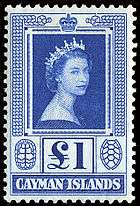
Foreign policy is controlled by the United Kingdom, as the islands remain an overseas territory of the United Kingdom. Although in its early days, the Cayman Islands' most important relationships were with Britain and Jamaica, in recent years, as a result of economic dependence, a relationship with the United States has developed.
Though the Cayman Islands is involved in no major international disputes, they have come under some criticism due to the use of their territory for narcotics trafficking and money laundering. In an attempt to address this, the government entered into the Narcotics Agreement of 1984 and the Mutual Legal Assistance Treaty of 1986 with the United States, to reduce the use of their facilities associated with these activities. In more recent years, they have stepped up the fight against money laundering, by limiting banking secrecy, introducing requirements for customer identification and record keeping, and requiring banks to co-operate with foreign investigators.
Due to their status as an overseas territory of the UK, the Cayman Islands has no representation either in the United Nations or in most other international organisations. However, the Cayman Islands still participates in some international organisations, being an associate member of Caricom and UNESCO, and a member of a sub-bureau of Interpol.[99]
Infrastructure
Ports
George Town is the port capital of Grand Cayman. There are no berthing facilities for cruise ships, but up to four cruise ships can anchor in designated anchorages. There are three cruise terminals in George Town, the North, South, and Royal Watler Terminals. The ride from the ship to the terminal is about 5 minutes.[100]
Air transport
Education
Primary and secondary schools
The Cayman Islands Education Department operates state schools. Caymanian children are entitled to free primary and secondary education. There are two public high schools on Grand Cayman, John Gray High School and Clifton Hunter High School, and one on Cayman Brac, Layman E. Scott High School. Various churches and private foundations operate several private schools.
Colleges and universities
The University College of the Cayman Islands has campuses on Grand Cayman and Cayman Brac and is the only government-run university on the Cayman Islands.[101]
The International College of the Cayman Islands is a private college in Grand Cayman. The college was established in 1970 and offers associate's, bachelor's and master's degree programmes.[102] Grand Cayman is also home to St. Matthew's University, which includes a medical school and a school of veterinary medicine.[103] The Cayman Islands Law School, a branch of the University of Liverpool, is based on Grand Cayman.[104]
The Cayman Islands Civil Service College, a unit of Cayman Islands government organised under the Portfolio of the Civil Service, is in Grand Cayman. Co-situated with University College of the Cayman Islands, it offers both degree programs and continuing education units of various sorts. The college opened in 2007 and is also used as a government research centre.
There is a University of the West Indies Open campus in the territory.[105]
Health and emergency services
See Health in the Cayman Islands.
Emergency services
The Royal Cayman Islands Police Service (RCIPS) provides law enforcement for the three islands. Regular off-shore marine and air patrols are conducted by the RCIP using a small fleet of vessels and a helicopter. Grand Cayman is a port of call for Britain's Royal Navy and the United States Coast Guard who often assist with sea rescues when their resources are in the Cayman Islands area. The Cayman Islands Fire Service provides fire prevention, fire fighting and rescue.[106] Its headquarters are in George Town and has substations in Frank Sound, West Bay, Cayman Brac and Little Cayman.[107]
Access to Emergency Services is available using 9-1-1, the Emergency telephone number, the same number as is used in Canada and the United States.[108] The Cayman Islands Department of Public Safety's Communications Centre processes 9-1-1 and non-emergency Police assistance, Ambulance Service, Fire Service and search and rescue calls for all three islands. The Communications Centre dispatches RCIP and EMS units directly; however, the Cayman Islands Fire Service maintains their own dispatch room at the airport fire station.[109]
Sports
Truman Bodden Sports Complex is a multi-use complex in George Town. The complex is separated into an outdoor, six-lane 25-metre (82 ft) swimming pool, full purpose track and field and basketball/netball courts. The field surrounded by the track is used for association football matches as well as other field sports. The track stadium holds 3,000 people.
Association football is the national and most popular sport, with the Cayman Islands national football team representing the Cayman Islands in FIFA.
The Cayman Islands Basketball Federation joined the international basketball governing body FIBA in 1976.[110] The country's national team attended the Caribbean Basketball Championship for the first time in 2011.
Rugby union is a developing sport, and has its own national men's team, women's team, and Sevens team. The Cayman Men's Rugby 7s team is second in the region after the 2011 NACRA 7s Championship.
The Cayman Islands is a member of FIFA, the International Olympic Committee and the Pan American Sports Organisation, and also competes in the biennial Island Games.[111]
The Cayman Islands is a member of the International Cricket Council which they joined in 1997 as an Affiliate, before coming an Associate member in 2002. The Cayman Islands national cricket team represents the islands in international cricket. The team has previously played the sport at first-class, List A and Twenty20 level. It competes in Division Five of the World Cricket League.[112]
Squash is popular in the Cayman Islands with a vibrant community of mostly ex-pats playing out of the 7 court South Sound Squash Club. In addition, the women's professional squash association hosts one of their major events each year in an all glass court being set up in Camana Bay. In December 2012, the former Cayman Open will be replaced by the Women's World Championships, the largest tournament in the world. The top Cayman men's player, Cameron Stafford is No. 2 in the Caribbean and ranked top 200 on the men's professional circuit.
Flag football (CIFFA) has men's, women's and co-ed leagues.
Other organised sports leagues include softball, beach volleyball, Gaelic football and ultimate frisbee.
The Cayman Islands Olympic Committee was founded in 1973 and was recognised by the IOC (International Olympic Committee) in 1976.
In the 21st century, skateboarding has become popular among the youth.
In February 2010, the first purpose-built track for kart racing in the Cayman Islands was opened.[113] Corporate karting Leagues at the track have involved widespread participation with 20 local companies and 227 drivers taking part in the 2010 Summer Corporate Karting League.[114]
Arts and culture
Music
The Cayman National Cultural Foundation manages the F.J. Harquail Cultural Centre and the US$4 million Harquail Theatre. The Cayman National Cultural Foundation, established in 1984, helps to preserve and promote Cayman folk music, including the organisation of festivals such as Cayman Islands International Storytelling Festival, the Cayman JazzFest, Seafarers Festival and Cayfest.[115] The jazz, calypso and reggae genres of music styles feature prominently in Cayman music as celebrated cultural influences.[116]
Art
The National Gallery of the Cayman Islands is an art museum in George Town.[117] Founded in 1996, NGCI is an arts organisation that seeks to fulfil its mission through exhibitions, artist residencies, education/outreach programmes and research projects in the Cayman Islands. The NGCI is a non profit institution, part of the Ministry of Health and Culture. [118]
Media
There is one print newspaper currently in circulation throughout the islands: the Cayman Compass. Online news services include the Cayman News Service and the Cayman Compass online edition. Local radio stations are broadcast throughout the islands.
Feature films that have been filmed in the Cayman Islands include: The Firm, Haven, Cayman Went[119] and Zombie Driftwood.[120]
Notable Caymanians
- Truman Bodden, politician
- Gladwyn K. Bush, folk artist
- McKeeva Bush, politician
- Marc Chin, cricketer
- William Warren Conolly, politician and national hero
- Kenneth Dart, businessman
- Selita Ebanks, fashion model
- Frank E. Flowers, filmmaker, director and screenwriter
- Marshall Forbes, footballer
- Ronald Forbes, Olympic athlete
- Brett Fraser, Olympic athlete
- Shaune Fraser, Olympic athlete
- Jason Gilbert, record producer and songwriter
- Tigerlily Hill, fashion designer and stylist
- Sybil Joyce Hylton, a national hero
- Kemar Hyman, Olympic athlete
- John Reno Jackson, multidisciplinary artist
- Thomas Jefferson, politician
- Sybil Ione McLaughlin, a national hero
- Alden McLaughlin, premier of the cayman islands
- Edison Mclean, first Caymanian gold medalist in Olympic skeet, Island Games[121]
- Cydonie Mothersille, track and field athlete and Olympian
- Edna Moyle, former Speaker of the House
- Bernard K. Passman, jeweller, founded his business on Grand Cayman in 1975
- Adrian ‘Gus’ Pope, Esquire, after being educated at University of Edinburgh, he won Thouron Award (1985 through 1986) to obtain LLM degree from University of Pennsylvania Law School (where he was starting flyhalf on Penn Law rugby union team), and then became global managing partner and head of the investment funds practice of largest law firm in Cayman Islands, Maples and Calder
- Lee Ramoon, footballer
- David Ritch, attorney and Chairman of the Board of Directors of CIBC FirstCaribbean International Bank
- Leila Ross-Shier, musician, educator and composer of "Beloved Isle Cayman"
- Cameron Stafford, 2010 Caribbean Junior Squash Champion
- Kareem Streete-Thompson, Olympic athlete
- Tanya Streeter, free-diver
- The Barefoot Man, folk singer and national icon
- Kurt Tibbetts, politician
- Dow Travers, Olympic athlete
- Jeffrey Webb, former CONCACAF president and FIFA vice president
- Michael Wight, cricketer
- Mary Evelyn Wood, a national hero
See also
- Outline of Cayman Islands
- Index of Cayman Islands-related articles
- Women's suffrage in the Cayman Islands
- Bay Islands Department - culturally contiguous with the Cayman Islands
References
- "Background Note: Cayman Islands". State.gov. 18 February 2011. Retrieved 31 July 2011.
- https://www.eso.ky/2020populationandhousingcensuspreparations.html#4
- "Central America :: Cayman Islands — The World Factbook - Central Intelligence Agency". www.cia.gov. Retrieved 14 September 2019.

- Cayman Islands. Data.un.org. Retrieved on 28 December 2019.
- Retrieved on 28 December 2019.
- Rogoff, Natasha Lance (19 February 2004). "Tax me if you can. Haven or Havoc?". pbs.org.
- "EU adds Cayman Islands to tax haven blacklist". Financial Times. 12 February 2020. Retrieved 16 February 2020.
- Stokes, Anne V.; Keegan, William F. (April 1993). "A SETTLEMENT SURVEY FOR PREHISTORIC ARCHAEOLOGICAL SITES ON GRAND CAYMAN". Florida Museum of Natural History, Gainesville. Retrieved 5 January 2013.
- "History of Cayman Islands". Retrieved 7 July 2019.
- "Encyclopedia Britannica – Cayman Islands". Retrieved 7 July 2019.
- "History of the Cayman Islands". Retrieved 7 July 2019.
- Bauman, Robert (2007) The Complete Guide to Offshore Residency. p. 115. ISBN 0-9789210-9-7.
- "Key to Cayman - HISTORY – ISLANDS THAT TIME FORGOT". 22 January 2016. Retrieved 7 July 2019.
- Keith Thompson, Life in The Caribbean (2010, ISBN 9987-16-015-8), p. 152
- "Cayman Islands History". Gocayman.ky. Archived from the original on 12 October 2008.
- The Cayman Islands Annual Report 1988 (Cayman Islands, 1988), p. 127
- Colonies in Conflict: The History of the British Overseas Territories by Charles Cawley
- Newman, Graeme R. (2010) Crime and Punishment Around the World: Africa and the Middle East. p. 82. ISBN 0-313-35133-3.
- Wood, Lawson (2007) The Cayman Islands. p. 12. ISBN 1-84537-897-0.
- Alfredo Zayas y Alfonso (1914). Lexografía Antillana. El Siglo XX Press, Havana.
- Biswas, Rajiv (2002) International Tax Competition: A Developing Country Perspective. Commonwealth Secretariat. p. 38. ISBN 0-85092-688-2.
- "Hurricane Ivan Remembered". Hazard Management Cayman Islands. Retrieved 26 July 2012.
- Thompson, Keith (2010) Caribbean Islands: The Land and the People. p. 152. ISBN 9987-16-018-2.
- "Grand Cayman's history with tropical systems". hurricanecity.com. Retrieved 31 July 2011.
- "Publications". Archived from the original on 23 December 2015. Retrieved 23 December 2015.
- Bush, Phillippe G. Grand Cayman, British West Indies. UNESCO Coastal region and small island papers 3.
- "Coordinates + total distance". web page. mapcrow. Retrieved 23 October 2011.
- "Quintana Roo to Cayman Islands". web page. distancesto. Retrieved 18 January 2015.
- "Distance from Cayman Islands to Cuba". web page. distancefromto.net/. 2011. Retrieved 23 October 2011.
- "Coordinates and total distance". web page. Mapcrow. Retrieved 23 October 2011.
- Bush. Unesco.org. Retrieved on 12 April 2014.
- Glenn Gerber. "Lesser Caymans iguana Cyclura nubila caymanensis". web page. The World Conservation Union. Archived from the original on 8 October 2011. Retrieved 23 October 2011.
- "World Atlas Highest and Lowest points". web page. Graphic Maps. Retrieved 23 October 2011.
- Woods, C.A.; Kilpatrick, C.W. (2005). "Infraorder Hystricognathi". In Wilson, D.E.; Reeder, D.M (eds.). Mammal Species of the World: A Taxonomic and Geographic Reference (3rd ed.). Johns Hopkins University Press. p. 1558. ISBN 978-0-8018-8221-0. OCLC 62265494.
- Red-footed Boobies of Little Cayman – National Trust for the Cayman Islands. Nationaltrust.org.ky. Retrieved on 12 April 2014.
- Cayman Brac | Caribbean Diving, Cayman Islands Vacation | Cayman Islands. Caymanislands.ky. Retrieved on 12 April 2014.
- Askew, R. R. and Stafford, P. A. van B. (2008) Butterflies of the Cayman Islands. Apollo Books, Stenstrup. ISBN 978-87-88757-85-9.
- Grand Cayman Blue Iguana takes step back from extinction Archived 11 November 2012 at the Wayback Machine. IUCN (20 October 2012). Retrieved on 12 April 2014.
- Cyclura lewisi, IUCN Red List. "Red List of Threatened Species". IUCN Red List of Threatened Species. Retrieved 26 June 2018.
- Morgan, Gary; Franz, Richard; Ronald Crombie (1993). "The Cuban Crocodile, Crocodylus rhombifer, from Late Quaternary Fossil Deposits on Grand Cayman" (PDF). Caribbean Journal of Science. 29 (3–4): 153–164.
- "The Cayman Islands – History". www.gov.ky. Retrieved 17 August 2018.
A 1523 map show[s] all three Islands with the name Lagartos, meaning alligators or large lizards, but by 1530 the name Caymanas was being used. It is derived from the Carib Indian word for the marine crocodile, which is now known to have lived in the Islands.
- "When to Go in Cayman Islands | Frommer's". www.frommers.com. Retrieved 28 September 2016.
- Boxall, Simon (9 September 2008). "Hurricane Ivan Remembered – Cayman Prepared". gov.ky. Retrieved 22 April 2012.
- "The Economics and Statistics Office". Government of the Cayman Islands. Retrieved 3 April 2019.
- "Regions and territories: Cayman Islands". BBC News. 29 April 2011. Retrieved 31 July 2011.
- ""World Population prospects – Population division"". population.un.org. United Nations Department of Economic and Social Affairs, Population Division. Retrieved 9 November 2019.
- ""Overall total population" – World Population Prospects: The 2019 Revision" (xslx). population.un.org (custom data acquired via website). United Nations Department of Economic and Social Affairs, Population Division. Retrieved 9 November 2019.
- "The Cayman Islands 2018 Compendium of Statistics" (PDF). Economics and Statistics Office. Retrieved 22 March 2020.
- "Central America :: Cayman Islands — The World Factbook - Central Intelligence Agency". www.cia.gov. Retrieved 5 August 2020.
- "The Cayman Islands – home to 100,000 companies and the £8.50 packet of fish fingers". The Guardian. 18 January 2016. Retrieved 16 February 2020.
- "CIA – The World Factbook – Rank Order – GDP – per capita (PPP)". Retrieved 25 April 2018.
- "Moving to Grand Cayman". CaymanNewResident.com. Archived from the original on 25 June 2014. Retrieved 21 July 2014.
- "The reality of Poverty In Cayman". Cayman Reporter. 5 August 2015. Archived from the original on 23 April 2016. Retrieved 11 April 2016.
- https://data.worldbank.org/indicator/SL.UEM.TOTL.NE.ZS?locations=KY&name_desc=true
- "A Bill for a Law to Increase Various Duties Under the Customs Tariff Law (2002 Revision); to Increase the Rates of Package Tax; And for Incidental and Connected Purposes" (PDF). Cayman Islands Legislative Assembly. 7 December 2009. Retrieved 25 June 2018.
- Seven Mile Beach | Grand Cayman, Caribbean Vacation | Cayman Islands. Caymanislands.ky. Retrieved on 12 April 2014.
- Pedro St. James | Grand Cayman, Grand Cayman Island | Cayman Islands Archived 12 January 2012 at the Wayback Machine. Caymanislands.ky. Retrieved on 12 April 2014.
- Stingray City | Grand Cayman, Grand Cayman Vacation | Cayman Islands. Caymanislands.ky. Retrieved on 12 April 2014.
- Tim Rock, Lonely Planet Diving & Snorkeling Cayman Islands (2nd edn, 2007, ISBN 1-74059-897-0), p. 99
- Kittiwake | Cayman Dive, Cayman Islands Vacation | Cayman Islands. Caymanislands.ky (5 January 2011). Retrieved on 12 April 2014.
- "piratesweek".
- "National Trust For the Cayman islands". Nationaltrust.org.ky. Retrieved 31 July 2011.
- Observation Tower | Camana Bay Archived 6 September 2014 at the Wayback Machine. CamanaBay.com. Retrieved on 1 August 2014.
- "CI shipping 2015/2016 annual report page 22" (PDF). cishipping.com. Retrieved 11 March 2019.
- "Work Permit Stats". Eso.ky. 30 March 2007. Archived from the original on 22 July 2011. Retrieved 31 July 2011.
- "C.I. Government Website – Entry Requirements for Work Permits". Gov.ky. Retrieved 31 July 2011.
- "Online Employment Resources". Island-search.com. Archived from the original on 10 August 2011. Retrieved 31 July 2011.
- Row brews over rollover, 22 January 2007, Cayman net News Archived 5 February 2009 at the Wayback Machine
- Government takes up permit issue Archived 14 September 2007 at the Wayback Machine, Editorial, 5 March 2006, Camanian Compass
- "Cayman Islands – Cay Compass News Online – Rollover for civil servants". Archived from the original on 6 March 2008. Retrieved 23 June 2008.
- "Cayman Observer". Archived from the original on 31 January 2017. Retrieved 23 June 2008.
- "CSME". immigration.gov.tt. Archived from the original on 26 March 2017. Retrieved 26 March 2017.
- "Country Profile for Cayman Islands — Caribbean Community (CARICOM)". caricom.org.
- "The Cayman Islands Constitution Order 2009" (PDF). legislation.gov.uk. 2009.
- "Commonwealth elections observers give Cayman Islands high marks". www.caribbeannewsnow.com. Caribbean News Now. 27 May 2013. Archived from the original on 10 January 2014. Retrieved 28 May 2013.
The amendment of elections law in 2012 increased the number of elected members of the Legislative Assembly from fifteen to eighteen.
- Cayman Islands Constitution, 2009, part III article 49
- Cayman Islands Constitution, 2009, part II
- Constitution, articles 55 and 81
- Constitution article 78
- Constitution article 43
- Constitution article 35
- "Governor Designate Roper arrives Monday". Retrieved 29 October 2018.
- The Constitution of the Cayman Islands, Part VI The Legislature
- "Official Register of Political Parties" (PDF). Cayman Islands Elections Office. 29 August 2018. Retrieved 29 August 2018.
- "Premier McLaughlin to lead 13-member coalition government". Cayman Compass. 31 May 2017. Retrieved 29 August 2018.
- https://www.rcips.ky/
- http://cbc.gov.ky/
- https://www.caymancompass.com/2019/10/13/cayman-regiment-would-provide-disaster-relief/
- https://www.caymancompass.com/2019/10/11/uk-minister-announces-cayman-regiment-for-emergency-relief/
- https://caymannewsservice.com/2019/10/cayman-to-create-military-regiment/
- http://www.gov.ky/portal/page/portal/cighome/pressroom/archive/201912/Regiment%20Begins%20Recruitment
- https://www.caymancompass.com/2020/01/30/regiment-senior-officers-appointed/
- https://www.cicadetcorps.ky/
- https://caymannewsservice.com/2018/08/cayman-islands-coast-guard-border-control/
- http://www.gov.ky/portal/page/portal/cighome/pressroom/archive/201907/CICG%20Deployed%20in%20International%20Joint%20Operation
- https://www.ieyenews.com/wordpress/cayman-islands-coast-guard-deployed-in-international-joint-operation/
- https://caymannewsservice.com/2019/11/coastguard-to-manage-stingray-city/
- "Cayman Islands History from 1700 to 1900". caymanresident.com. 16 December 2019. Retrieved 16 December 2019.
- "United Kingdom / Europe / Member countries / Internet / Home – INTERPOL". Interpol.int. 30 December 2012. Retrieved 30 December 2012.
- "Cayman Islands Cruise – Grand Cayman Island, Grand Cayman – Cayman Islands". caymanislands.ky.
- "University College Cayman Islands: About us". Ucci.edu.ky. Archived from the original on 22 July 2011. Retrieved 31 July 2011.
- International College of the Cayman islands: Programs of Study Archived 1 January 2011 at the Wayback Machine
- "St. Matthew's University". Stmatthews.edu. Archived from the original on 8 August 2011. Retrieved 31 July 2011.
- "Cayman Islands law School". Liv.ac.uk. Archived from the original on 14 January 2012. Retrieved 31 July 2011.
- http://open.uwi.edu/cayman_islands
- "Cayman Islands Fire Service". Cifs.gov.ky. Retrieved 31 July 2011.
- "CIFS locations". Caymanchamber.ky. Archived from the original on 5 October 2011. Retrieved 31 July 2011.
- "EMERGENCIES" (PDF). Travel.State.Gov U.S. DEPARTMENT OF STATE — BUREAU OF CONSULAR AFFAIRS. 29 July 2018.
- "What We Do". www.gov.ky. Retrieved 29 July 2018.
- FIBA National Federations – Cayman Islands, fiba.com, accessed 28 October 2015.
- "NatWest Island Games XVI Jersey 2015 Results – Sports – Swimming – Men's 200m Individual Medley". jersey2015results.com.
- "International Cricket Council: Cayman Islands". Icc-cricket.yahoo.net. Archived from the original on 27 September 2011. Retrieved 31 July 2011.
- "Go-karting track up to speed" Archived 20 April 2010 at the Wayback Machine, Caymanian Compass, 23 February 2010
- "Parker's eased into top gear", Caymanian Compass, 24 September 2010.
- CNCF. "Cayman Festival and Events | Cultural Schedule". www.artscayman.org. Retrieved 4 February 2018.
- Cayman Islands, Online Radio. "Pop music from Cayman Islands". Online Radio Box. Retrieved 21 June 2018.
- Quinnie110 (5 June 2009). "Cayman Went (2009)". IMDb.
- i-obi. "Zombie Driftwood (2010)". IMDb.
- Island Games Results Isle of Wight 2011 | Sports | Shooting | Olympic Skeet Individual – Men. Natwestiowresults2011.com. Retrieved on 12 April 2014.
Further reading
- Boultbee, Paul G. (1996). Cayman Islands. Oxford: ABC-Clio Press. ISBN 9781851092406. OCLC 35170772.
- "History of the Cayman Islands". Caribbean Magazine. Archived from the original on 11 May 2011. Retrieved 28 July 2010.
- "Cayman Islands". 2005 CIA World Factbook. Retrieved 4 July 2005. Originally from the CIA World Factbook 2000.
- Michael Craton and the New History Committee (2003). Founded upon the Seas: A History of the Cayman Islands and Their People. Kingston, Jamaica: Ian Randle Publishers. ISBN 0-9729358-3-5.
- "Non-Self-Governing Territories listed by General Assembly in 2002". United Nations Special Committee of 24 on Decolonization. Archived from the original on 3 December 2008. Retrieved 4 July 2005.
External links
| Wikimedia Commons has media related to Cayman Islands. |
- . Encyclopædia Britannica. 5 (11th ed.). 1911.
- Cayman Islands Government
- Cayman Islands Department of Tourism
- Cayman Islands Travel Guide

- Cayman Islands Film Commission
- "Cayman Islands". The World Factbook. Central Intelligence Agency.
- Cayman Islands from UCB Libraries GovPubs.
- Cayman Islands at Curlie
- Cayman National Cultural Foundation
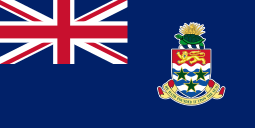


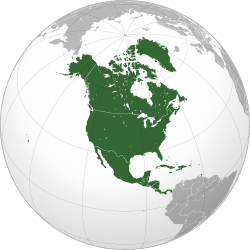
Countries.png)